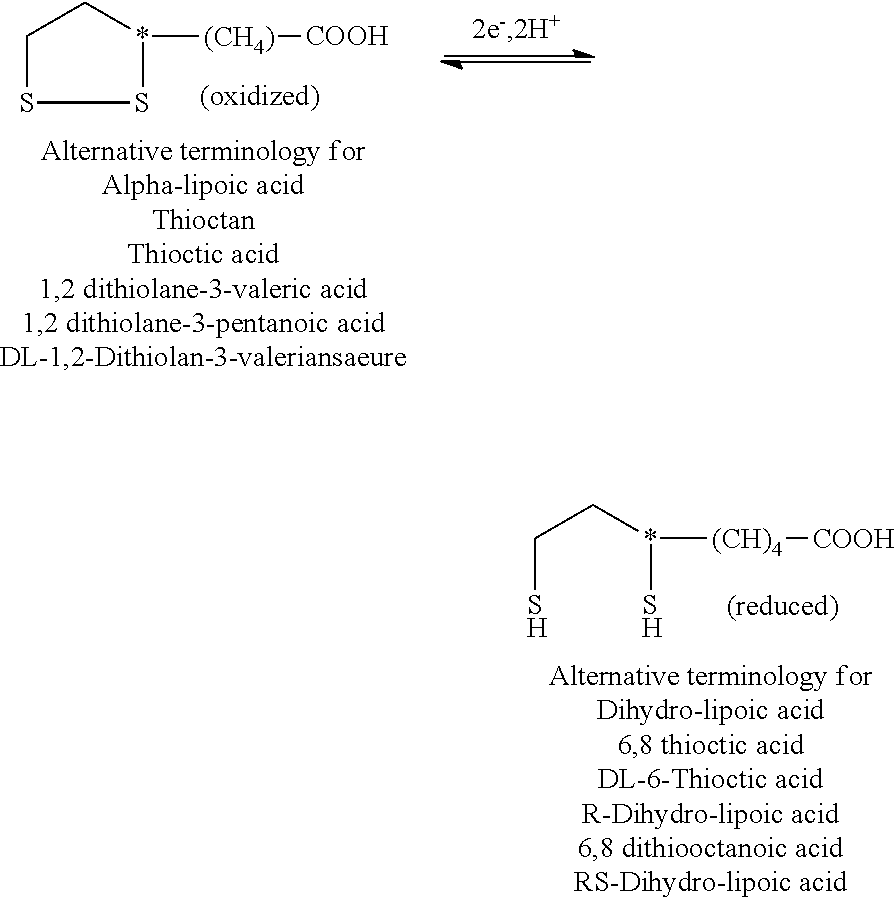Materials and methods for treatment of disorders associated with oxidative stress
a technology of oxidative stress and materials, applied in the field of inflammation bowel disease, can solve the problems of affecting the natural history, no currently available medical therapeutic modality, and few treatment modalities, and achieve the effects of reducing activity, increasing the incidence and prevalence of ulcerative colitis, and reducing the risk of side effects
- Summary
- Abstract
- Description
- Claims
- Application Information
AI Technical Summary
Benefits of technology
Problems solved by technology
Method used
Image
Examples
example 1
Treatment of Patient During Induction Phase
[0204]It has been discovered that ulcerative colitis, like many other diseases can be prevented if it is recognized during the induction phase. Recognition of the induction process is difficult since there are little or no symptoms or signs pointing to the colon as the source of the problem and the colon is histologically and macroscopically normal. Recognition at this stage requires a high index of suspicion coupled with some knowledge of the extra intestinal manifestations, xenobiotic associations, family and genetic history, ulcerative colitis epidemiological data and life style history.
[0205]A p-anca antibody at this time may be positive if the colonic epithelial barrier has been rendered sufficiently permeable to allow prolonged contact between the immune system and bacterial antigens in the colon. The p-anca antibody has been shown to be directed against a surface antigen of B. Valgantus and is an indication of colonic barrier breach ...
example 2
Treatment of Patient During Propagation Phase
[0207]Currently, individuals are almost never recognized during the induction phase and only seek medical help because of rectal bleeding when the propagation phase has already developed. A colonic neutrophilic inflammatory reaction into the colonic mucosa cannot be reversed with the same measures used during the induction phase, although it is prudent to institute them in order to prevent re-induction after reversal of the inflammatory reaction has been accomplished.
[0208]Treatment of colonic inflammation during the propagation phase comprises one or more of the following:
[0209]1. Neutralization of colonic hydrogen peroxide.
[0210]2. Reduction of neutrophilic stimulation by colonic bacteria.
[0211]3. Termination of colonic epithelial cell lipid peroxidation.
[0212]4. Reduction of colonic mucosal permeability.
[0213]Neutralization of hydrogen peroxide is critical in order to terminate continued tissue damage. This can be accomplished, for exa...
example 3
Clinical Treatment of Patient in Propagation Phase
[0219]A 25 year old female who just quit smoking, with a history of alcohol use, on birth pills, taking NSAIDS for aches and pains and laxatives for constipation, who lives on a high fat fast foods, with a demanding job and stressful personal life, and who has a cousin with ulcerative colitis is at high risk for induction and subsequent development of the disease. This patient presented with rectal bleeding which had been ongoing for about one year.
[0220]The patient was treated with a 150 cc rectal retention enema comprising sodium thiosulfate, bismuth subgallate, vitamin E, and cromolyn sodium administered once a day before bedtime for one month. After the first month, treatment was modified to administration of the enema every other day for an additional month. Dietary and lifestyle modification was also instituted. Rectal bleeding ceased by the third day of treatment and the patient has not exhibited any further rectal bleeding fo...
PUM
| Property | Measurement | Unit |
|---|---|---|
| gut transit time | aaaaa | aaaaa |
| concentration | aaaaa | aaaaa |
| weight | aaaaa | aaaaa |
Abstract
Description
Claims
Application Information
 Login to View More
Login to View More - R&D
- Intellectual Property
- Life Sciences
- Materials
- Tech Scout
- Unparalleled Data Quality
- Higher Quality Content
- 60% Fewer Hallucinations
Browse by: Latest US Patents, China's latest patents, Technical Efficacy Thesaurus, Application Domain, Technology Topic, Popular Technical Reports.
© 2025 PatSnap. All rights reserved.Legal|Privacy policy|Modern Slavery Act Transparency Statement|Sitemap|About US| Contact US: help@patsnap.com


